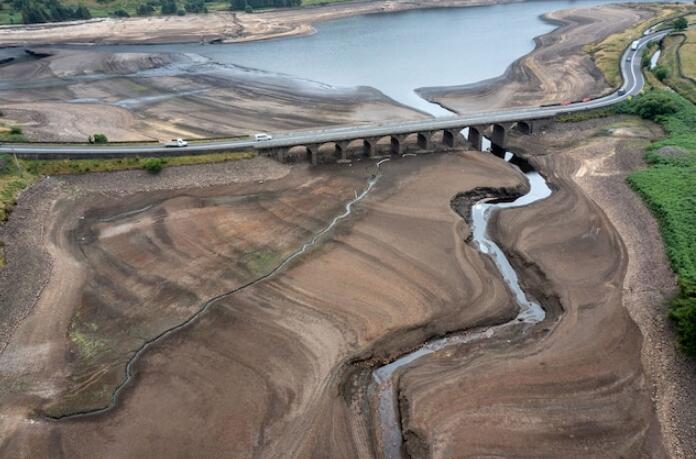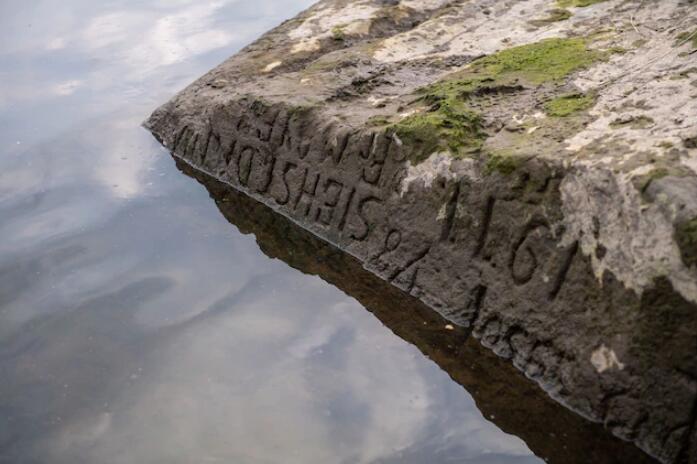 欧洲的水资源危机比我们想象的要严重得多
欧洲的水资源危机比我们想象的要严重得多
Europe’s water crisis is much worse than we thought
译文简介
地下水开采过度,欧洲的干旱问题如何应对。
正文翻译

This year’s historic drought was just one part of the story: New findings reveal an alarming decline of freshwater in the continent’s aquifers.
今年的历史性干旱只是故事的一部分,还远没有结束。新的发现表明,欧洲大陆含水层的淡水数量在以惊人的速度下降。
As drought dried up rivers and reservoirs across Europe this year, grim warnings from the past surfaced from the depths. Wenn du mich siehst, dann weine, read the inscxtion on a “Hunger Stone” exposed on a bank of the River Elbe in the Czech Republic: “If you see me, then weep.”
随着今年欧洲的河流和水库干涸,过去的严峻警告终于从深海浮出了水面。丹·温恩看到了捷克易北河岸边一块“饥饿石”上的题词:“如果你看到我,那就哭泣吧。”
Still, as bad as the drought appeared on the surface, a new satellite analysis estimating freshwater availability in Europe shows that “what’s even worse is the groundwater story that people cannot see,” says the hydrologist Jay Famiglietti, director of the Global Institute for Water Security at Canada’s University of Saskatchewan.
加拿大萨斯喀彻温大学全球水安全研究所主任、水文学家Jay Famiglietti表示,尽管干旱在地表上的表现已经很糟糕了,但一项对欧洲淡水可用性的新卫星分析数据显示,“更糟糕的是人们看不到的地下水情况。”
Famiglietti and collaborators analyzed two decades of data from the U.S./German satellite missions known as GRACE to find the rate of change in freshwater stored on the European continent. GRACE’s twin satellites track changes in gravity to measure large stores of water such as those held underground in aquifers; flowing in lakes and rivers; and frozen in ice sheets and glaciers. The larger the water mass, the stronger the gravitational pull.
为了了解欧洲大陆储存的淡水的变化率,Famiglietti和他的同事分析了美国和德国GRACE卫星20年来的数据。GRACE的两颗卫星利用跟踪重力的变化来测量各类的水储存,如地下含水层中的水; 在湖泊和河流中流动的水; 被冻结在冰原和冰川中的水等。水的质量越大,引力作用就越强。
The results suggest a steady depletion of water in aquifers—the porous rock and soil layers underfoot that store most of the world’s non-frozen freshwater—between 2002 and 2022. With some exceptions including Scandinavia, most of the continent is losing far more groundwater each year than is being replaced by rainfall and other recharge, Famiglietti says.
研究结果表明,在2002年至2022年期间,含水层(地下多孔的岩石和土层,储存着世界上大部分非冻结淡水)的水将持续枯竭Famiglietti说,除了包括斯堪的纳维亚半岛在内的一些地方外,欧洲大陆大部分地区每年流失的地下水远远超过了降雨和其他补给所补充的水量。

The researchers estimate average overall water loss in Europe at about 84 gigatons a year since the turn of the 21st century. It’s an alarming rate, Famiglietti says, roughly equal to all the water in Lake Ontario, or five times the average annual flow of the Colorado River through the Grand Canyon. The scale—a gigaton represents a billion tons of water—is almost impossible to wrap your mind around. But that’s the scale at which climate change is happening.
研究人员估计,自21世纪初以来,欧洲平均每年的总失水量约为840亿吨。Famiglietti说,这个流失速度非常惊人,相当于每年流失一个安大略湖的水量,或科罗拉多河流经大峡谷的年平均流量的五倍。一个gigaton代表10亿吨的水————这个量几乎是超出人们的想象。但这就是气候变化正在发生的规模。
The underlying cause is clear, he says. Too little in some places and too much in others, “water is the messenger delivering the bad news of climate change” to people around the world. But excessive groundwater extraction plays a significant role in the losses.
他说,这背后的原因很清楚。在有些地方水太少,而在另一些地方则太多,“水是向全世界人民传递气候变化坏消息的信使”。但过度开采地下水是造成损失的重要原因。
Climate change and aquifer over-pumping are tied together in a tough knot. As severe droughts become more frequent, agricultural, industrial, and urban users pump more water from greater depths to compensate for lack of rain and record heat. Aquifers can’t recover as they could when the rains returned after historic droughts like those marked on the Hunger Stones of the former Bohemia.
气候变化和含水层过度抽取是密切相关的。随着严重干旱变得越来越频繁,降水量的缺乏和创纪录的热量不得不让农业、工业和城市用户从更深的地下抽更多的水来协调正常生活。这导致蓄水层无法像历史上的波西米亚饥饿石上所标记的干旱那样恢复到之前的水平。
GRACE and other models are part of the growing and urgent case for better understanding and management of aquifers, says the Paris-based hydrogeologist Alice Aureli, chief of groundwater sustainability and water cooperation at UNESCO. This year’s drought was the worst in 500 years, according to European Commission scientists. The specter of scarcity has “made even the water-abundant countries afraid,” Aureli says. “Unfortunately, people take action only when they are afraid.”
联合国教科文组织地下水可持续性和水资源合作司司长、常驻巴黎的水文地质学家Alice Aureli说,GRACE和其他模型是更好地理解和管理含水层的日益增长和紧迫情况的一部分。据欧盟委员会的科学家称,今年的干旱是500年来最严重的一次。Aureli说,水资源短缺的恐惧“甚至让水资源丰富的国家都感到害怕”。“不幸的是,人们只有在害怕的时候才会采取行动。”
The GRACE missions
GRACE任务
The Gravity Recovery and Climate Experiment, a mission of NASA and the German Aerospace Centre, first sent its pair of satellites into orbit in 2002. The two work like a balance scale, tracking change over time by measuring water’s gravitational pull. The amount of water on Earth remains constant, and the freshwater we need for life is only a sliver of the total. But climate change and other human alterations—from draining wetlands to damming rivers or pumping aquifers—can move that freshwater in significant and dangerous ways, drying a lake or unleashing a flood.
重力恢复和气候实验是美国宇航局和德国航空航天中心的一项任务, 2002年,他们首次将其两颗卫星送入轨道。两者的工作原理就像一个平衡秤,它们通过测量水的引力来跟踪其随时间的变化。地球上的水量是恒定的,而我们赖以生存的淡水只是总水量的一小部分。但气候变化和其他人类活动——从排水湿地到筑坝修建河流或抽取蓄水层——都可能以大规模而危险的方式移动淡水,进而使湖泊干涸或引发洪水。
The original GRACE mission, which ended in 2017, “showed us critical things like our global map of groundwater depletion—and that the human fingerprint on the freshwater landscape is the dominant actor,” Famiglietti says. It also showed that the world’s mid-latitudes, including the U.S. Southwest and much of Europe, are drying as predicted by the Intergovernmental Panel on Climate Change (IPCC). But the drying is not in some distant future; it’s happening now—faster than IPCC projections.
最初的GRACE任务于2017年结束,“该任务向我们展示了一些关键的信息,比如我们的全球地下水枯竭地图,这些淡水资源附近的人类足迹是淡水资源枯竭的主要原因,” Famiglietti说道。报告还显示,正如政府间气候变化专门委员会(IPCC)预测的那样,包括美国西南部和欧洲大部分地区在内的世界中纬度地区正在变得干燥。干旱并不是在遥远的未来才会发生; 实际上干旱正在发生,甚至在以比IPCC预测的还要快的速度发生。
In 2018, the U.S. and Germany launched GRACE Follow-On, nicknamed GRACE-FO, a carbon copy of the original mission. GRACE-FO has revealed how little progress has been made in protecting the world’s freshwater, Famiglietti says. “We are simply continuing down the same downward path and in some places, worse,” including in Europe.
2018年,美国和德国推出了GRACE后续计划,绰号GRACE-FO,这是最初任务的翻版。Famiglietti说,GRACE-FO收集的数据表明人类在保护世界淡水资源方面收效甚微。“我们只是在继续沿着同样的下坡路走下去,在某些地方,情况甚至更糟,”这其中也包括欧洲。
The new GRACE data “ground-truths” what other computer models reveal about aquifer depletion, says Marc Bierkens, a professor of hydrology at Utrecht University in the Netherlands. He and other modelers have long sounded the alarm about the acceleration of groundwater losses as pumping for irrigation, industry, and public supply outpaces the rate of natural recharge.
荷兰乌得勒支大学的水文教授Marc Bierkens说,新的GRACE数据“真实地反映了”其他计算机模型所揭示的含水层耗竭的情况。长期以来,随着灌溉、工业和公共供应的抽水速度加快,这已经超过了自然水补给的速度。因此, 他和其他建模者一直在发出关于地下水流失加速的警报。
Working with researchers from the International Groundwater Resources Assessment Center and Deltares, Bierkens’ team has also shown how aquifer depletion contributes to global sea-level rise. Most of the groundwater pumped up from wells does not return to its aquifer but eventually evaporates and becomes rain. That rain falls either directly into the ocean—or onto land that then drains to streams and rivers and ultimately to seas. Bierkens estimates groundwater’s contribution to sea level rise at 10 to 15 percent, “large enough to be taken into account when understanding where current sea level rise is coming from.”
Bierkens的团队还与国际地下水资源评估中心和Deltares的研究人员合作,他们一同展示了含水层的枯竭是如何导致全球海平面上升的。大部分从井中抽出的地下水不会回到含水层,而是最终蒸发成雨。雨水要么直接落入海洋,要么落在陆地上,然后流入小溪和河流,最终流入海洋。Bierkens估计地下水对海平面上升的贡献为10%至15%,“在了解目前海平面上升的原因时,这一数字足以被考虑在内。”
While GRACE and other satellite models are good at “picking up big patterns,” Bierkens says, the continental scale is also their disadvantage. Communities and nations can’t manage groundwater sustainably without a clearer picture of its natural and human vagaries: How water recharges, moves through and leaves local aquifers. What specific crops, industries, and urban demands are tapping the water below. Soil types and depths. Vegetation and trees.
Bierkens表示,虽然GRACE和其他卫星模型擅长“捕捉大的规律”,但大陆的超大规模也是它们的弱点。如果不能更清楚地了解地下水的自然和人为变化,社区和国家就无法可持续地管理地下水。因此,水是如何补充的、如何流经和离开当地含水层的,当地有种植什么作物、有什么工业以及城市用水需求、土壤类型和深度、植被和树木等信息都需要了解。
Bierkens is leading an effort to build thousands of such variables into a grid-based groundwater model that covers Earth’s land area in more than a hundred million square-kilometer cells, each a window to the aquifers below. Layered with weather, land-use and other datasets, the model can help clarify the extent to which water losses are being driven by pumping versus climate change and other variables, as well as the solutions possible—the projected effects, say, of restored wetlands, reduced pumping, or recharge projects.
Bierkens及其工作人员正在努力将数千个这样的变量构建到一个基于网格的地下水模型中,该模型以超过1亿平方公里的单元格覆盖地球陆地面积,每个单元格都是通往地下含水层的窗口。该模型结合了天气、土地使用和其他数据集,可以帮助阐明抽水与气候变化和其他变量在多大程度上会导致水的损失,以及可能的解决方案——比如恢复湿地、减少抽水或补给项目的预期影响等。
Out of sight, out of mind
眼不见心不烦
Whether from space or a square-kilometer grid, helping people see the fate of groundwater is fundamental to saving it, says UNESCO’s Aureli. Unlike in rivers, where what happens upstream becomes obvious to those living downstream, groundwater’s flow can be disturbed and changed in subtle and surprising ways. There is also a protective sense, “that this is my water, no one can see what I have, so why should I tell them?” Aureli says. “This can be my reserve.”
联合国教科文组织的Aureli说,无论是从太空还是平方公里的网格,帮助人们看到地下水的命运是拯救地下水的基础。对于河流来说,上游发生的事情对生活在下游的人来说影响是显而易见的,但是地下水不同,地下水的流动可能会以微妙和令人惊讶的方式受到干扰和变化。其中还有一种保护意识,“这是我的水,没有人能看到我所拥有的水,那我为什么要告诉他们?”Aureli说。“这可以是我的储备。”
That mystery and invisibility put the world’s most important source of available freshwater out of sight and out of mind for too long, Aureli says. But this year’s drought emergency revealed the urgency to better safeguard water in the face of scarcity that can desiccate grain harvests in Italy, shutter nuclear reactors in France, and close off major shipping arteries in Germany.
Aureli说,这种神秘性和隐形性使世界上最重要的淡水来源被人们遗忘和忽略了太久。但今年的干旱紧急情况表明,保护水资源十分紧迫。不然意大利粮食歉收、法国核反应堆关闭以及关闭德国主要航运动脉等事情将屡屡出现。
Member governments of the UN convene regularly around major crises such as climate change, most recently at COP27 in Egypt, and biodiversity losses, the focus of COP15 this month in Montreal. But UN member states have not been able to agree to come together to negotiate on water in nearly half a century. Aureli attended the Mar Del Plata UN Conference on Water in 1977 as an 18-year-old college student. Hardly anyone was talking about groundwater back then, she says.
联合国成员国政府定期召开会议,讨论气候变化等重大危机。最近一次会议是在埃及举行的COP27,以及本月在蒙特利尔举行的旨在关注生物多样性丧失的COP15会议。但近半个世纪以来,联合国成员国一直未能同意就水资源问题进行谈判。1977年,18岁的Aureli参加了马德普拉塔联合国水会议,当时她还只是一名大学生。她说,当时几乎没有人谈论地下水的问题。
The story will be different in spring 2023 when the UN convenes its second major intergovernmental water conference, in New York City. As a lead-up to that meeting, a special groundwater summit this Wednesday and Thursday at UNESCO headquarters in Paris focuses in part on how nations can better share aquifers that span political boundaries. Familglietti will present some of his team’s new satellite findings—being prepared for publication this spring by colleague Hrishikesh Chandanpurkar and others—and make a case for water’s importance in COP and other climate negotiations.
2023年春季,联合国将在纽约市召开第二次重要的政府间水会议时,届时情况将有所不同。作为这次会议的准备工作,本周三和周四在巴黎联合国教科文组织总部举行的地下水特别峰会将会部分关注各国如何更好地分享跨越政治边界的含水层的问题。Familglietti将介绍他的团队的一些新卫星发现,这些发现将由其同事Hrishikesh Chandanpurkar和其他人在今年春天发表,同时他们也将说明水在COP和其他气候谈判中的重要性。
Unlike the days when groundwater was shrouded in mystery, “now we have facts in hand,” Aureli says.
不像过去那些地下水被神秘笼罩的日子,“现在我们已经掌握了事实,” Aureli说。
Wealthy nations also have solutions at hand, says the Danish hydrogeologist Karen Villholth, director of South Africa-based Water Cycle Innovation. Those include ecological restoration, aquifer recharge, and managing demand. Denmark, for example, has cut per-capita water use in half, from nearly 200 liters a day in the 1980s to closer to 100 liters today, she says. Increasing the cost of water, and a focus on reuse and other efficiency measures, have helped make the difference.
南非水循环创新中心主任、丹麦水文地质学家Karen Villholth说,富裕国家手头也有解决方案。其中包括生态恢复、含水层补给和管理需求等。她表示,例如,丹麦的人均用水量减少了一半,从1980年代的每天近200升减少到今天的近100升。增加水的成本,以及对再利用和其他效率措施的关注,都有助于改变现状。
Groundwater could also be a “game-changer” for climate justice, Villholth says, given that it’s over tapped in high-income countries and under-developed in low-income ones. As wealthy nations overcome water waste, they can support low-income nations in developing aquifers for basic water supply and small-scale businesses. “Why are most poor countries, like in Africa, not getting support to develop their groundwater resources,” she asks, “when they have not induced a hotter and more hostile climate?”
Villholth说,地下水也可能成为气候正义的“游戏规则改变者”,因为高收入国家过度开发地下水,而低收入国家的地下水源开采欠发达。 随着富裕国家克服水资源浪费,它们可以支持低收入国家开发用于基本供水和小型企业的含水层。“为什么大多数贫穷国家,比如非洲国家,没有得到开发地下水资源的支持,”她问道,“因为他们没有遇到更热、更恶劣的气候?”
Still, much like climate denial, the myth of freshwater abundance remains entrenched despite mounting evidence otherwise. No recent European water strife reveals it better than Tesla’s first manufacturing plant on the continent. Southeast of Berlin, Gigafactory Berlin-Brandenburg is ramping up in an area beset by declining groundwater levels. When a reporter last fall questioned CEO Elon Musk about local concerns that the plant will usurp water from the community and ecosystems, he laughed aloud and called her “completely wrong.”
尽管如此,就像否认气候一样,淡水丰富的神话仍然根深蒂固于人们心中,尽管有越来越多的证据表明并非如此。最近所有发生在欧洲的水冲突都不如特斯拉在欧洲大陆的第一家制造工厂的现状更能揭示水资源缺乏的问题。在柏林东南部,柏林-勃兰登堡超级工厂正在一个受地下水位下降困扰的地区加紧发展。去年秋天,当一名记者向特斯拉首席执行官埃隆·马斯克(Elon Musk)询问当地对该工厂将从社区和生态系统中侵占水的担忧时,他大笑起来,称她的论调“完全错误”。
“It’s like water everywhere here,” Musk said. “Does this seem like a desert to you? It’s ridiculous. It rains a lot.”
马斯克回应说:“这里到处都是水。你觉得这像是一片沙漠吗?你说的话简直是无稽之谈,而且这儿降水很多。”
Planned expansion of the plant has been delayed amid the severity of this year’s drought.
但事实却是由于今年干旱的严重性,该工厂的扩建计划已被推迟。
评论翻译
无
很赞 ( 1 )
收藏